
Tantalizing Tofu Menus of the Past
Written by Team MUSUBI
Tofu is like a white canvas, waiting to be transformed into a culinary masterpiece. While a simple dish of hiyayakko can provide a quick and satisfying escape, why not delve a bit deeper into the past for some newfound inspiration?
Tofu Hyakuchin, one of the most popular cookbooks from the Edo period (1603 CE–1868 CE), introduces an impressive array of 100 tofu menus. It features recipes ranging from ordinary to unique, and echoes the culinary traditions of a bygone era. In the nearly past two centuries, some of these recipes have remained beloved classics, while others have faded with the passage of time. Join us as we prepare some of these ancient recipes, offering you some new dishes to discover and try.
Table of Contents
About Tofu Hyakuchin
However, it is important to note that this reception may have been limited to urban areas as rural regions in northern Japan were suffering from a widespread famine at the time.

jinjohin (尋常品): Everyday dishes that might require some verbal instruction
tsuhin(通品): Dishes whose preparation is self-explanatory by name alone
kahin(佳品): Dishes with superior flavor and attractive presentation
kihin(奇品): Unique and unusual dishes
myouhin(妙品): More intricate and beautiful than kihin, yet delicious
zeppin(絶品): The pinnacle of tofu dishes, showcasing the true essence of tofu
Interestingly, the tsuhin section offers merely a list of dish names rather than recipes, highlighting the common culinary knowledge of the time.
Actual Recipes for Now to Make
Curious to see what the recipes were actually like, we tried a mix of easy-to-make choices and some suited for the summer. The book does not mention any measurements. All dishes were prepared with a dash of intuition and several rounds of tasting.
Here is what we made:
Hiyayakko

Listed in the tsuhin section, hiyayakko is the epitome of simplicity and perfect for summer. Traditionally, it was served in one-inch cubes. According to another Edo-period text, common condiments included grated daikon, green chili pepper paste, nori seaweed, wasabi, and dried citrus peel. However, in present-day servings, the usual condiments are grated ginger, sliced green onions, bonito flakes and soy sauce.
Kinome Dengaku

Found in the jinjohin section, this dish features tofu grilled with kinome, the leaves of Japanese sansho peppers, and miso. The tofu is cut, skewered on a stick, and placed in a bowl filled with mildly hot water. Each slice is then coated with flavored miso and lightly grilled. The secret seems to be adding amazake to the miso for a slight sweetness. This versatile miso topping also goes perfectly with fried eggplants and simmered daikon.
Kaminari Tofu

Also from the jinjohin section, this dish is made by cooking hand-crushed tofu in a heated pan with sesame oil and soy sauce. After plating, the finished dish is topped with chopped green onions, grated daikon, and wasabi.
Fuwafuwa Tofu

This simmered dish is prepared by mixing equal parts tofu and eggs, and then heating the mixture in a pan. It's a wonderful choice when you are looking to stretch your ingredients. Very mild and comforting in texture and flavor.
Kori Tofu

Listed under kihin, kori tofu is indeed unique. A slice of tofu is set in a transparent, bland jelly and eaten cold. There is no reference to any specific seasoning or condiments, only a simple mention of “season to taste.” We tried ours first with ponzu and then with kuromitsu, a thick brown sugar syrup. Sweet was definitely the preferred flavor over savory.
Tofu became a popular staple among the general population during the Edo period. Looking through all the recipes, it’s clear that most dishes stay true to and enhance the inherent flavors of tofu. Enjoy exploring these historical recipes and bringing a taste of Edo-period Japan to your table!
If you’re taking a trip to Tokyo and have a craving for this soy delight, check out Tofu Shokudo in Ebisu and taste the natural flavors of soybeans in their in-house made tofu and soy milk.







Leave a comment
This site is protected by hCaptcha and the hCaptcha Privacy Policy and Terms of Service apply.